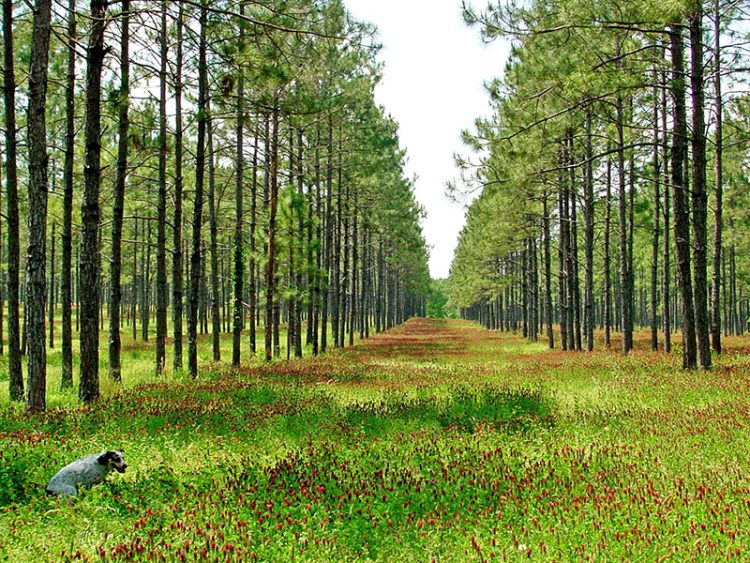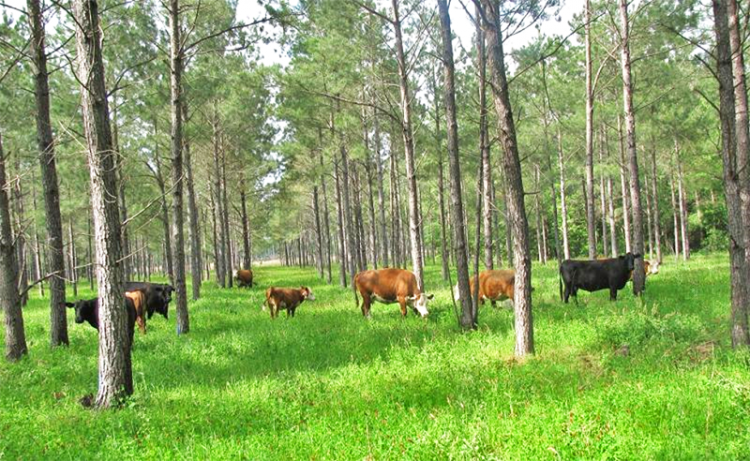Stephen Greer, County Extension Director, UF/IFAS Extension Santa Rosa County
Agroforestry comes in many forms where trees, the primary crop, are managed in combination with other crops and/or animals to create a more diverse agriculture community with the potential to improve environmental quality and yield for all components of the system. Florida’s heat and extended periods of wet and dry weather can lead to plant stress and reduced performance. This reduced performance can ultimately impact the economic viability of the operation. Agroforestry systems create options to reduce some of these plant stresses that are not available in traditional tree plantations or other crop and animal production settings.
Traditional plantation forestry utilizes tree spacings that create a canopy density that will not allow for integration with other crops or animals on the site. These sites can be intentionally thinned, creating the opportunity to include other crops and animals in the system. Sites can also be intentionally planted utilizing tree spacing and patterns that allow agroforesty systems to be utilized immediately. This is an important consideration if you are reforesting as a result of Hurricane Michael or after a timber harvest.
In the Panhandle of Florida, many agriculture areas are under development pressure. This pressure increases the need for more efficient production, and ultimately, more income from a property – agroforestry systems can help address both of these issues. Producing multiple crops on the same property helps spread production risk and generates incomes at more frequent intervals. Overall efficiency can be increased through the interactions of the trees, crops, and livestock. An excellent example of this is the more efficient cycling of nutrients often seen of agroforesty sites.
The positive impacts on the environment and beauty of these enterprises is often overlooked. Additionally, on sites with erodible soil, it is important to establish practices that significantly reduce these losses — agroforestry practices are a viable option. Maintaining a stable plant cover over these sites allows for improved water infiltration of rainfall, leading to larger contributions to groundwater and greater drought resiliency on the site.
Trees planted with a wide row spacing for the purpose of windbreaks also block for windborne pests moving from one area of open crops lands to another. Growing other tree or shrubs species between planted pine windbreaks provides a density to catch and slow pest movement. A balance of beneficial to harmful insect populations are often found in these diverse planting areas reducing the potential for harmful insects to go unchecked.
Agroforestry offers the opportunity to add an alternate business that can address the long cycles between tree planting and timber harvest events. Silvopasture, a type of agroforestry, involves creating forage areas in wide row middles. Cattle or small ruminant grazing can occur in the areas. The wide tree rows provide partial shade to reduce heat stress on the animals, and the tree roots capture any nutrients not absorbed by the forage crop. Other alternative crops produced in conjunction with timber could range from ornamental nursery crops, select fruit trees and shrubs, specialty crops such as herbs, mushrooms, pine straw or palmetto. These type of farming businesses provide another source for annual income for family farm business operations.

Crimson clover overseeded on bahia/loblolly pine silvopasture on the Owens Farm, in Washington County. Credit: Doug Mayo, UF/IFAS
–
Taking time to develop a complete plan or success with an agroforestry site involves an important set of steps establishing the foundation to meet your set agricultural goals. It is advisable to request assistance from your local extension office, your county forester, or private forestry professionals, as this is a long-term commitment that can help support the family farm well into the future.
–
For more information on this topic, use the following links:
USDA Agroforestry
Agroforestry: Options for Landowners
Integrated Timber, Forage, and Livestock Production—Benefits of Silvopasture
Establishment of Silvopasture in Existing Pastures
- Land Management to Enhance Wild Turkey in the Panhandle - September 29, 2023
- Healthy Forest Management - April 14, 2023
- Benefits of a Forestry Consultant - October 7, 2022

